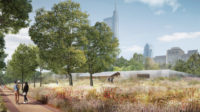Exhibition Review: Toward an Architectural Archive at Japan's National Archives of Modern Architecture

The exhibition materials are displayed in a series of curved vitrines that form a circle within the main room of the Archives building.

Towards an Architectural Archive
National Archives of Modern Architecture
Tokyo, Japan

National Archives of Modern Architecture
Tokyo, Japan

National Archives of Modern Architecture
Tokyo, Japan

National Archives of Modern Architecture
Tokyo, Japan

National Archives of Modern Architecture
Tokyo, Japan






The exhibition materials are displayed in a series of curved vitrines that form a circle within the main room of the Archives building.
Japan is one of the many countries—both Eastern and Western—that hasn’t been sufficiently respectful of its modernist architectural heritage. Still, preservationists in most countries would envy Japan its National Archives of Modern Architecture, conceived by the late architectural historian Hiroyuki Suzuki and created by the government in 2012.
The Archives benefits from public funding, its own building (within the Kyu-Iwasaki-tei Garden in Tokyo’s Yushima neighborhood), and, if that weren’t enough, Tadao Ando as its honorary director. It will initially focus on collecting architectural drawings and documents from the post-War era, then expand into earlier and later periods. And don’t fear for its survival. The Archives says in its promotional materials that it will save the Japanese government money because original architectural drawings “are indispensable” when public buildings are renovated. If the message isn’t clear enough, the Archives goes on to say: “Like the wheels of a car, the construction work and the archival work must operate together.” Brilliant marketing—making an institution essential to architects and academics seem like a cost-cutting measure!
Last year, the Archives mounted its first exhibition; called Tokyo Olympics in Architectural Documents, it focused on Kenzo Tange’s iconic Yoyogi Stadium (1964) and proposals for a stadium for the 2020 Tokyo Olympics, now mired in controversy. Its second offering, cleverly titled Toward an Architectural Archive (through August 24), is a look at the connection between Le Corbusier and three Japanese architects. One of them, Junzo Sakakura, studied under Corbu from 1931 to 1939 and designed the Japanese pavilion for the Paris World Exposition of 1937—a bit of Japanese modernism abroad. Back home, Sakakura designed the Museum of Modern Art in Kamakura, said to be the first public art museum in Japan and a building as modern as any of the works it showcased. (It was chosen in a competition that was considered a bellwether of Japan’s acceptance of modernist architecture.) Opened in 1951, it bears a strong resemblance to Corbusier’s Villa Savoy, though on a larger scale (about 16,000 square feet). The building is threatened with demolition when its land lease expires in 2016. The photos in the show, and Sakakura’s original axonometric drawing, won’t in themselves save the museum, but they will help by drawing attention to its lineage.
There are many other gems, including drawings by Takamasa Yoshizaka, who worked for Corbu in 1950 on a scholarship funded by the French government and went on to translate many of the master’s work into Japanese. One of his oddest buildings, seen in photographs, is the upside-down pyramid known as the Inter-University Seminar House (1965). Adding a lot of color to the largely monochromatic show is a section of materials about the theater curtain Le Corbusier designed for Sakakura’s Shibuya Pantheon Theater in the 1950s. The theater was demolished in 2003 and the 33-by-79-foot curtain is now owned by the Archives. Among the other highlights is work by Masato Otaka, one of the last living members of the Metabolist movement, including stunning pencil drawings for his City on the Sea (Plan for Tokyo Bay). Otaka was an apprentice to another of Le Corbusier’s Japanese protégés, Kunio Maekawa.
The show itself is beautifully installed, much of it in a series of curved vitrines that form a circle within the main room of the Archives building. A smaller circle, the target on the bulls-eye, serves as a pedestal for a few of the crumbling boxes, tubes, and binders in which the documents have been stored for decades, making the past palpable. Meanwhile video oral histories play on a screen upstairs, adding yet another dimension to the show. The Archives is off to a very promising start.









